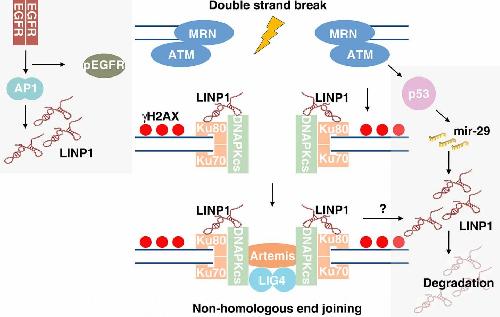PHILADELPHIA - The discovery of long non-coding RNA (lncRNA) has dramatically changed the understanding of the biology of diseases such as cancer. The human genome contains about 20,000 protein-coding genes - less than 2 percent of the total - but 70 percent of the genome is made into non-gene-encoding RNA.
Take triple-negative breast cancer (TNBC), an aggressive subtype with poor clinical outcome, for example. Genomic studies of TNBC to crack its tough-to-treat status have mainly focused on protein-coding genes and the function of non-coding genes is still largely unknown. Using a clinically guided genetic screening approach, researchers from the Perelman School of Medicine at the University of Pennsylvania identified LINP1, a lncRNA. This lncRNA is overexpressed in triple-negative breast cancer cells and regulated by the tumor suppressor p53 and the activated cell surface protein, EGFR. LINP1 enhances the repair of DNA breaks by serving as a scaffold that links two other proteins in the repair machinery.
A BRCA1 mutation is associated with a higher risk for TNBC, which represents about 10 to 20 percent of all breast cancer cases. TNBC test negative for both the estrogen and progesterone receptors and the cell surface receptor Her2, hence its name. Since hormones are not supporting growth, the cancer is unlikely to respond to hormonal therapies and medications that target HER2.
 LINP1 enhances the repair of DNA breaks by serving as a scaffold that links two other proteins in the repair machinery. Credit: The lab of Lin Zhang, MD, Perelman School of Medicine, University of Pennsylvania
LINP1 enhances the repair of DNA breaks by serving as a scaffold that links two other proteins in the repair machinery. Credit: The lab of Lin Zhang, MD, Perelman School of Medicine, University of Pennsylvania
Because of these limited therapeutic targets, many cancers, including TNBCs, are typically treated with surgery and a combination of radiation and chemotherapy that induce various types of DNA damage. However, many TNBC patients are resistant to these combination therapies.
With support from the Basser Center for BRCA at Penn, the team was led by senior authors Lin Zhang, MD, the Harry Fields Associate Professor of Obstetrics and Gynecology, Chi V. Dang, MD, PhD, director of the Abramson Cancer Center, and first author Youyou Zhang, MD, PhD, a postdoctoral fellow in the department of Obstetric and Gynecology. They published their findings this week in Nature Structural & Molecular Biology. Recent studies, including publications from the Penn group, have identified lncRNAs with tumor suppressive and oncogenic activities in cancers.
Building Bridges
The two repair scaffold proteins, Ku80 and DNA-PKcs, that LINP1 links coordinate the non-homologous end-joining (NHEJ) repair molecules that fix double-strand breaks in DNA. Importantly, the team found that blocking LINP1 significantly increases sensitivity by the tumor cells to radiation therapy.
The NHEJ pathway, which repairs double-strand breaks in DNA, is one of the major pathways in tumor cells that respond to radiation treatment and chemotherapeutic agents. Inhibition of the NHEJ pathway has been proposed by oncology researchers to synergize DNA-damaging therapies for better treatment outcomes for TNBCs.
"Given the important role of LINP1 in the NHEJ pathway, our study indicates that this new class of cancer-driver gene -- the lncRNAs -- may serve as unique therapeutic targets and novel biomarkers in cancer," Zhang said. "Collectively, our study provides new insight into the DNA damage repair pathway, long non-coding RNAs, and triple-negative breast cancer."
source: University of Pennsylvania School of Medicine